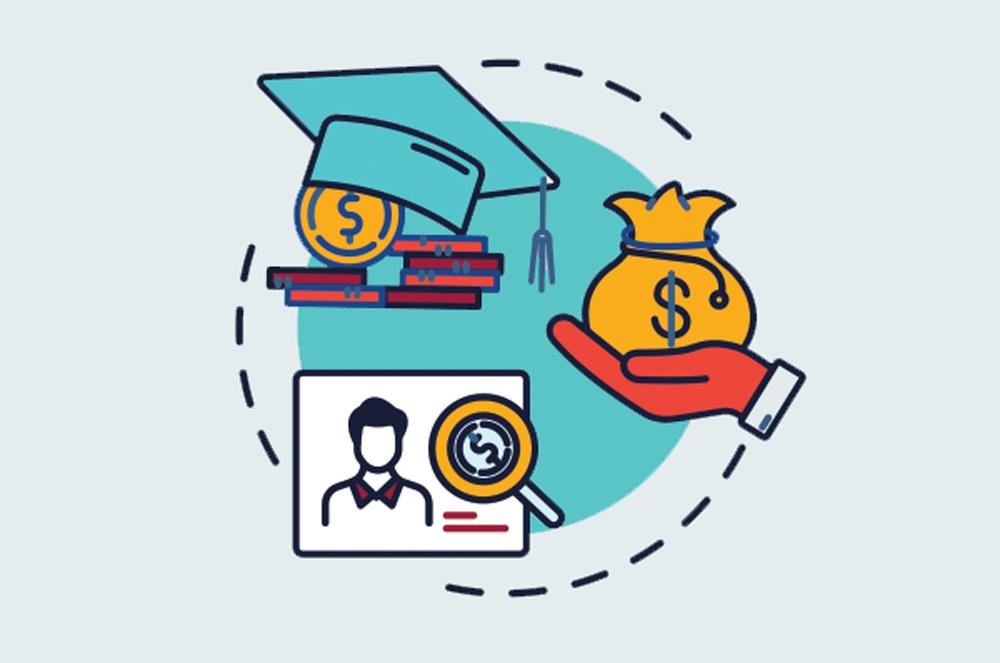Navigating the labyrinth of financial aid might seem as daunting as mastering a foreign language or decrypting ancient hieroglyphs. Yet, understanding this complex tapestry is essential for students and families dreaming of higher education without the nightmarish debt that often accompanies it. Every year, millions of dollars in aid wait patiently to be claimed, while students trudge along, unaware or intimidated by the process required to reach these funds. This article aims to demystify the maze of financial assistance, offering a torchlight of clarity that illuminates your path to funding your education. Whether you are a high school senior eyeing the ivy-wrapped walls of academia or a returning student aiming to finish a degree, this guide will serve as your compass in the world of grants, loans, scholarships, and work-study programs. Let’s embark on this educational journey to uncover the secrets of financial aid, making your academic dreams an attainable reality.
Table of Contents
- Understanding the Basics of Financial Aid
- Exploring Types of Financial Aid Available
- Maximizing Your Financial Aid Package Through Smart Application Strategies
- Navigating Repayment: Tips and Tricks for Managing Your Student Loans
- In Conclusion

Understanding the Basics of Financial Aid
When you start exploring the realm of higher education, understanding how you can finance this endeavor is crucial. Here’s a digestible breakdown of the essential elements you will encounter on your journey through the maze of financial aid.
Firstly, financial aid comes in several forms: scholarships, grants, loans, and work-study programs. Each type serves a unique purpose and caters to different needs. Scholarships and grants are highly sought after as they do not require repayment, making them a fundamental pillar of affordable higher education. On the other hand, loans must be repaid, typically with interest, whereas work-study provides a part-time job that helps students earn money while continuing their studies.
| Type | Description | Repayment |
|---|---|---|
| Scholarships | Merit or need-based funding | Not required |
| Grants | Need-based funding usually from governments | Not required |
| Loans | Borrowed money | Required with interest |
| Work-Study | Part-time employment | No repayment necessary |
To navigate through these options, it’s essential to familiarize yourself with FAFSA (Free Application for Federal Student Aid). This free form is your gateway to understanding what federal, state, and even institutional aid you might qualify for. It collects information about your financial circumstances, and that of your family, to determine the amount of financial aid you can receive.
It’s not just about filling out the FAFSA once and forgetting about it. You must reapply every year. Each year can bring different financial circumstances and may affect the aid you receive, making annual submission a critical step in maintaining your funding throughout college.
- Maintain a Calendar: Track deadlines for FAFSA and scholarships to ensure all potential aid sources are tapped.
- Document Organization: Keep financial documents readily available as they are crucial for applications.
- Review Offer Letters: Understand each aid offer and how it affects your financial obligations.
While figuring out financial aid can be daunting, many universities offer financial aid counseling. These services can help students understand their offers, the nuances of loan repayment terms, and how to budget and manage their personal finances effectively.
Through all these stages, remember that the landscape of financial aid is complex and often changing. Staying informed about new federal regulations or institutional offers can ensure you maximize your benefits each academic year.

Exploring Types of Financial Aid Available
Embarking on an educational journey can be exciting, but often the path is paved with financial challenges. Fortunately, a variety of financial aid options exist to help ease the monetary burden. Understanding the different types can help students and families make informed decisions, tailored to their specific needs.
Grants are perhaps the most attractive type of financial aid because they don’t require repayment. These are often need-based, with federal Pell Grants being one of the most common. Grants can also be found through state governments and private institutions, and are frequently awarded on the basis of both need and merit.
Scholarships are awarded based on a multitude of criteria ranging from academic achievements and athletic ability to community service and field of study. They do not require repayment, making them highly sought after. Scholarships can come from various sources, including businesses, schools, religious groups, nonprofits, and community organizations.
Student Loans offer another avenue of financial aid, though these funds must be repaid, often with interest. Federal student loans generally have lower interest rates compared to private student loans. The U.S. Department of Education offers Subsidized loans (the government pays interest while you’re in school) and Unsubsidized loans.
Work-Study Programs provide students with a way to earn money for their education through part-time jobs either on or off campus. These programs are available to those with financial need and not only provide financial aid but also valuable work experience.
Understanding these options further, consider the following comparisons between scholarships, grants, and loans:
| Type of Aid | Need to Repay | Source |
|---|---|---|
| Grants | No | Federal, State, Private |
| Scholarships | No | Various organizations |
| Student Loans | Yes | Federal, Private |
For many, the combination of these financial aids is the key to covering all educational expenses. It’s a balancing act between finding funds you don’t have to pay back and managing those you do.
Additionally, some educational institutions offer specific fellowship or assistantship programs for graduate students. These programs not only cover tuition costs but may also provide a stipend. They are highly competitive and require the students to partake in research or teaching duties.
It’s also worth exploring less traditional sources of funding such as crowd-sourced educational funding. Platforms like GoFundMe can be utilized to rally support from your community, especially in circumstances when traditional financial aid may not fully cover educational needs.
Ultimately, by combining these different forms of financial aid, students can piece together a funding mosaic that makes their educational aspirations both attainable and affordable. Every little bit helps, and with the right approach, the financial load of higher education can become significantly lighter.

Maximizing Your Financial Aid Package Through Smart Application Strategies
Navigating the maze of financial aid can feel overwhelming, but arm yourself with these tactical approaches to enhance your chances of securing the best possible aid package. It’s not just about filling out forms; it’s about strategic planning and timely action.
Start Early: One of the most effective strategies is to begin the financial aid process as early as possible. Many forms of aid, especially grants and scholarships, are awarded on a first-come, first-served basis. By preparing your applications ahead of the deadline, you ensure maximum consideration for many limited funding sources.
Understand the Forms: It’s crucial to thoroughly understand the forms you are required to fill out. The Free Application for Federal Student Aid (FAFSA) is the standard for U.S. federal aid, but many schools also require the CSS Profile for additional non-governmental aid. Familiarize yourself with the nuances of each to avoid common errors that could delay or reduce your aid.
Highlight Unique Circumstances: Make sure to communicate any unique financial circumstances to the financial aid office. Situations such as a family member’s recent unemployment or unusual medical expenses can impact your aid eligibility. Documenting these can lead to adjustments in your aid package.
Here are three key types of aid to consider when applying:
- Grants and Scholarships: These are ideal because they do not require repayment. Look for both federal and private options.
- Work-Study Programs: These programs allow you to work part-time while studying, helping you cover education costs without requiring repayment.
- Loans: These should be your last resort, used only when other forms of aid don’t cover your needs. Always opt for federal loans over private loans if possible, as they typically offer lower interest rates and more flexible repayment conditions.
Effective research into potential scholarships can hugely impact your aid package. Explore scholarships offered through your prospective institution, but also check other organizations like civic groups, companies, and nonprofit organizations.
| Source | Amount | Type | Application Deadline |
|---|---|---|---|
| University Merit Scholarship | $5,000/year | Merit-based | January 15 |
| Local Rotary Club Scholarship | $1,000 | Community Service | March 1 |
| National Science Grant | $3,000 | Subject-specific | February 20 |
A proactive approach in directly communicating with the financial aid office can also make a significant difference. Set up a meeting to discuss your aspirations, your financial situation, and how the school can help meet your needs. Continuous engagement with the office can place you on their radar and potentially lead to increased aid upon availability.
Keep Accurate Records: Maintain impeccable records of all your applications and correspondences regarding financial aid. This organized approach will help you track what you’ve applied for, the upcoming deadlines, and the responses from scholarship committees. Keeping accurate records can also be invaluable for appealing decisions or rectifying mistakes in the aid application processes.
Paying for education is undeniably challenging, but with a thorough and methodical approach to applying for financial aid, the journey can be less daunting and more successful. Focus on application accuracy, respecting deadlines, and following up diligently, and you might find that the cost of your education becomes significantly more manageable.

Navigating Repayment: Tips and Tricks for Managing Your Student Loans
Starting the journey of paying off student loans can feel like navigating through a maze. Here are some practical tips to help you manage this financial challenge effectively:
Understand Your Loans: It’s crucial to have a clear grasp of what you owe. Take the time to list all your loans, including details about the interest rates, loan terms, and creditor information. This will help you in planning your repayment strategy.
Setting Up a Budget: Creating a budget that accounts for your student loan payments is essential. Consider your monthly income and expenses to determine how much you can realistically afford to pay toward your loans each month.
| Expense | Cost |
|---|---|
| Rent/Mortgage | $1,200 |
| Utilities | $200 |
| Groceries | $300 |
| Student Loan | $350 |
| Miscellaneous | $150 |
Consider Consolidation: If managing multiple payments is overwhelming, consider consolidating your loans. This can simplify your payments and possibly lower your interest rate. However, make sure to weigh the pros and cons, as consolidation might reset any progress towards loan forgiveness programs.
Exploring Repayment Options: You might qualify for income-driven repayment plans if your current payments are too high relative to your income. These plans adjust monthly payments based on your earnings and family size, making them more manageable.
- Revised Pay As You Earn Repayment Plan (REPAYE)
- Pay As You Earn Repayment Plan (PAYE)
- Income-Based Repayment Plan (IBR)
- Income-Contingent Repayment Plan (ICR)
Set Up Automatic Payments: Mismanaging your student loan can lead to missed payments and late fees, negatively impacting your credit score. Setting up automatic payments can avoid this and sometimes even get you a discount on your interest rate.
Extra Payments: Whenever possible, making more than the minimum payment can help you reduce the principal faster and save on interest. Even small additional amounts can make a big difference over time.
Tax Deductions: Did you know you might be able to deduct the interest you pay on your student loans? This can reduce the amount of your income subject to taxes, possibly providing extra money that could go toward your loan payments.
As you navigate the repayment process, remember you’re not alone. Many tools and resources can help you along the way, and seeking advice from a financial advisor can be beneficial. Staying informed and proactive will help you conquer your student loans more efficiently and restore financial freedom faster.
In Conclusion
As we wrap up this insightful journey through the labyrinth of financial aid, remember that navigating these waters, though complex, is just a step in the grand adventure of education. Knowledge is the compass that will guide you through, and armed with the information shared in this article, you’re better equipped to chart your course toward a brighter academic future. Whether you’re just embarking on your academic voyage or you’re a seasoned learner seeking new opportunities, financial aid can be the wind in your sails that propels you forward. Keep exploring, keep asking questions, and above all, keep pursuing your educational dreams with tenacity and courage. Wherever your academic endeavors lead you, let the insights from today illuminate your path ahead.
